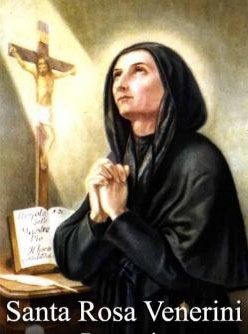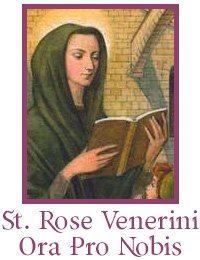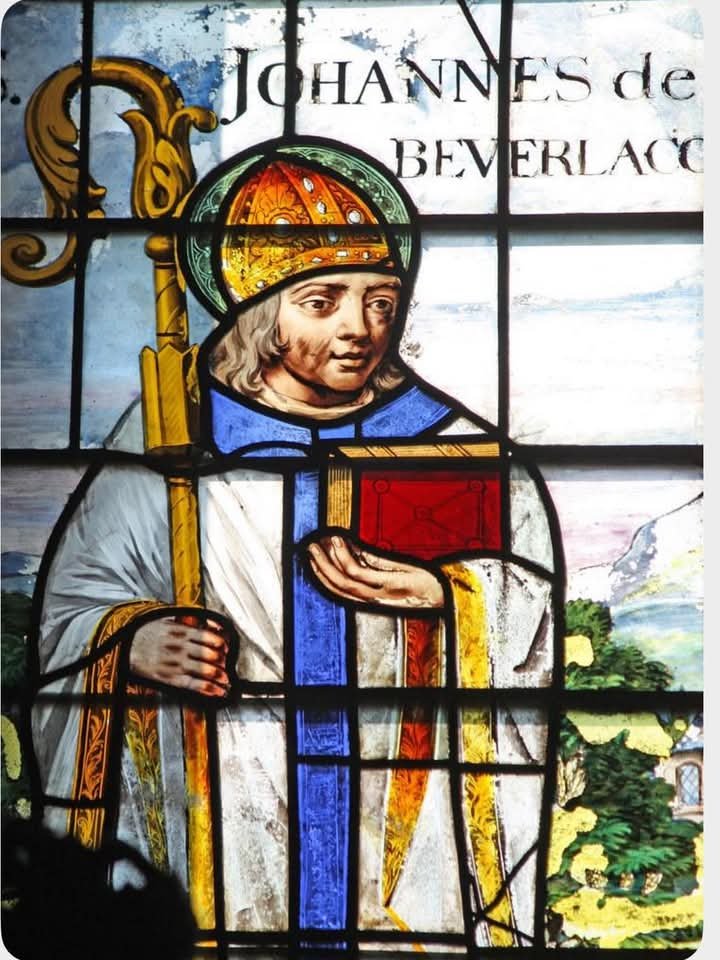FEAST OF SAINT ROSA VENERINI, VIRGIN
FEAST DAY – 7th MAY
Rosa Venerini, M.P.V. (9 February 1656 – 7 May 1728) was a pioneer in the education of women and girls in 17th-century Italy and the foundress of the Religious Teachers Venerini (Italian: Maestre Pie Venerini), a Roman Catholic religious institute of women, often simply called the Venerini Sisters. She was canonized by Pope Benedict XVI on 15 October 2006.
Venerini was born in 1656 in Viterbo, Italy, then a part of the Papal States. Her father, Goffredo, originally from Castelleone di Suasa, Ancona, after having completed his medical studies at Rome, moved to Viterbo where he practiced at the major hospital of the city. From his marriage to Marzia Zampichetti, of an ancient family of the city, four children were born.
According to her first biographer, Father Girolamo Andreucci, S.J., Venerini made a vow to consecrate her life to God at the age of seven. At age twenty, though, Rosa had questions about her own future and chose to accept an offer of marriage. Her fiancé, however, died shortly after this.
In the autumn of that year, on the advice of her father, Venerini entered the Dominican Monastery of St. Catherine, where her aunt was a member of the monastery. She remained in the monastery for only a few months, however, because the sudden death of her father forced her to return to care for her mother. Her brother, Domenico, then died at 27.

A few months later, worn out by grief, her mother also died. In the meantime, Rose’s sister Maria Maddalena married. There remained at home only Orazio and Rosa, by now 24 years old. Rosa began to gather girls and women of the area in her own home to recite the rosary.
After Venerini’s first contacts with the Dominican friars at the Sanctuary of Our Lady of the Oak Tree, near Viterbo, she chose to follow the spirituality of St. Ignatius of Loyola under the direction of the Jesuits, especially Father Ignatius Martinelli, who became her spiritual director. Under his guidance, she saw the need to dedicate herself to the instruction and Christian formation of the young.
On 30 August 1685, with the approval of the Bishop of Viterbo, Cardinal Giulio Cesare Sacchetti, and the collaboration of two friends, Gerolama Coluzzelli and Porzia Bacci, Rosa left her father’s home to begin her first school. The first objective of this foundress was to give poor girls a complete Christian formation and to prepare them for life in society.
Without great pretense, Rose opened the first public school for girls in Italy. The initial stages were not easy. The three teachers had to face the resistance of clergy who considered the teaching of the catechism as their private office. But the harshest suspicion came from conformists who were scandalized by the boldness of this woman of the upper middle class of Viterbo, who had taken to heart the education of ignorant girls.
With her characteristic strength, Rosa continued on the path that she had undertaken. The same pastors recognized the moral improvement that the work of education generated among the girls and their mothers. The validity of this initiative was acknowledged and its fame went beyond the confines of the diocese.
Cardinal Marcantonio Barbarigo, Bishop of Montefiascone, had the insight to understand the Viterbo project and he invited Venerini to come to his diocese to give advice on the administration of schools in the diocese and to help train teachers. From 1692 to 1694, she opened ten schools in Montefiascone and the villages surrounding Lake Bolsena.

The cardinal provided the material means and Rosa made the families aware of the value of education for their daughters, trained the teachers, and organized the schools. When she had to return to Viterbo to attend to her first school, Venerini entrusted the Montefiascone schools and the teachers to the direction of a young woman, St. Lucia Filippini.
She recognized in Filippini particular gifts of mind, heart and spirit and knew the strong qualities of Fillipini, whom the cardinal had entrusted with the leadership of the project in his diocese. Filippini organized the teachers of that diocese as a separate religious congregation known as the Religious Teachers Filippini.
After the openings in Viterbo and Montefiascone, other schools were started throughout the region of Lazio. Venerini was invited to Rome in 1706 to establish a school, but the attempt was a failure, which caused her to wait six long years before regaining the trust of the authorities.
On 8 December 1713, with the help of Abbot Degli Atti, a friend of the Venerini family, Rosa was able to open a school in the center of Rome, at the foot of the Campidoglio. On 24 October 1716 the Sisters received a visit by Pope Clement XI, accompanied by eight cardinals, who wanted to observe the lessons.
At the end of the morning he addressed these words to Rose: “Signora Rosa, you are doing that which we cannot do. We thank you very much, because with these schools you will sanctify Rome ”. From that moment on, governors and cardinals asked for schools for their areas.
The duties of the foundress became intense, consisting of travels and hard work, interwoven with joys and sacrifices for the formation of new communities. Wherever a new school sprang up, in a short time a moral improvement could be noted in the youth.
Rose Venerini died at the community at the Basilica of San Marco in Rome on the evening of 7 May 1728. By then, she had opened more than 40 schools. Her remains were entombed in the nearby Jesuit Church of the Gesù, so loved by her. In 1952, on the occasion of her beatification, they were transferred to the chapel of the General Motherhouse in Rome.
The Sisters went to the United States in 1909, primarily to help the Italian immigrants to that country, establishing the first day care centers in many cities of the Northeastern United States. They served in Switzerland from 1971 to 1985 and the congregation has since extended its apostolic activity to other lands: India, Brazil, Cameroon, Romania, Albania, Chile, Venezuela and Nigeria.
Venerini was canonized by Pope Benedict XVI on 15 October 2006. Her feast day is 7 May.
PRAYER
O God, who raised up blessed Rose Venerini in your Church to show others the way of salvation, grant us, by her example, so to follow Christ the master, that we may come with our neighbor into your presence.
Through our Lord Jesus Christ, your Son, who lives and reigns with you in the unity of the Holy Spirit, one God, for ever and ever. Amen

Saint Rose Venerini, pray for us.
*************************************
ALSO CELEBRATED:

ST. JOHN OF BEVERLY – MAY 7
John of Beverly was an early English bishop, a contemporary of St.
Bede’s, and a monk of St. Hilda’s great monastery at Whitby. As a young man, he studied at the school set up by Archbishop Theodore at Canterbury and was taught by Abbot Hadrian there.
After the death of St. Eata, who had been St. Cuthbert’s abbot at Melrose and later bishop of Lindisfarne, St. John of Beverly was appointed to replace him in 686. He ordained Bede to the diaconate and later to the priesthood, and Bede in his History of the English Church and People speaks of him with great affection. John’s love and care of the poor as well as his love of solitude and prayer became legendary.
Bede tells the lovely story of John’s concern and care of a young boy who had difficulty speaking and who could say little more than “Ah.” The bishop patiently taught him to speak, first one-syllable words like “yes,” and then longer words and sentences. It is indicative of the great charity of the man and his deep interest in the welfare of others. In 705, on the death of St. Bosa, John of Beverly was appointed archbishop of York.
This was a difficult position, since St. Wilfrid had been driven from that see by the king of Northumbria and was still alive. John of Beverly had taken little part in the controversy but found himself in a delicate position. He carried on at York with the same simplicity and devotion he had shown at Hexham, building himself a monastery at Beverly to which he would retire from time to time. He spent a dozen years at York, beloved by all, deeply revered by his priests and people, and noted for his many miracles.
In 717, a very old man, he resigned his bishopric to St. Wilfrid the Younger, retired to his monastery at Beverly, and spent the last four years of his life in prayer and contemplation. He died on May 7, 721, and his feast is kept in Hexham and the northern dioceses of England. His shrine at Beverly became a place of pilgrimage, miracles and sanctuary during the Middle Ages and his relics are still kept at the church in Beverly.
It is tragically remembered In 1541, the shrine was destroyed on the orders of Henry VIII as part of the English Reformation. We have to pray for the church of England to come back to the Catholic faith.
PRAYER
Dear God, the surest sign of closeness to Christ is kindness to all, especially the poor and the unfortunate. St. John of Beverly went out of his way to be kind, and his memory lived on among the people he served. Help us towards the cultivation of kindness, as it is at the very heart of holiness, and if we are seriously interested in being holy, we have to be kind. In Jesus’ Name we pray. Amen







